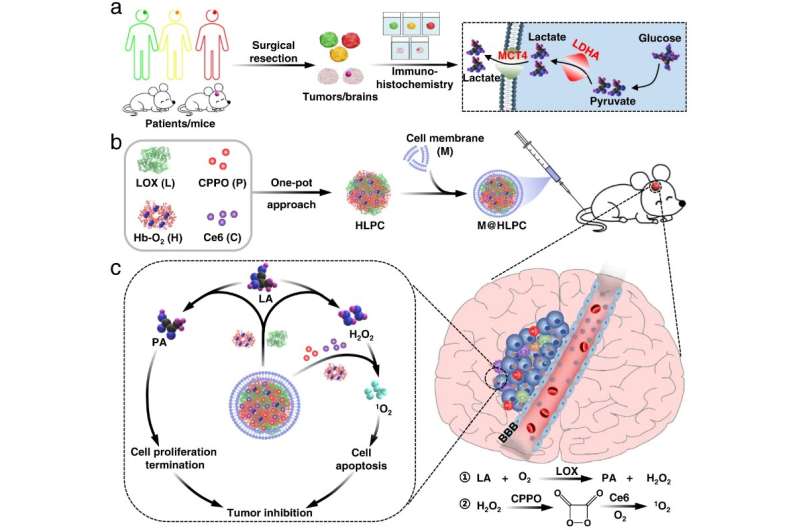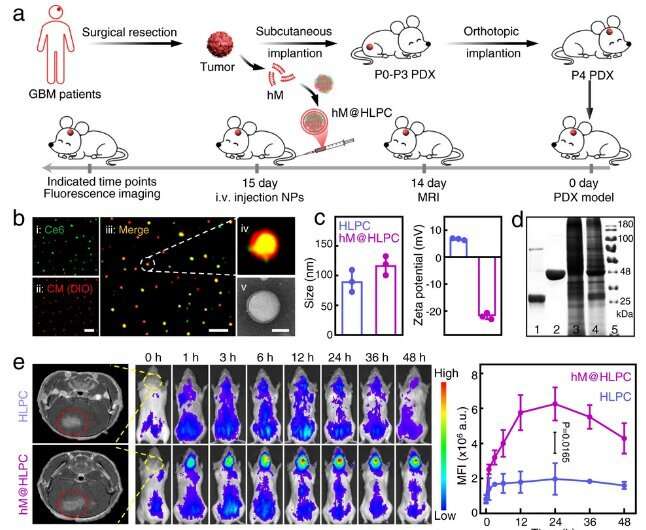Scientists develop new biomimetic formulation for treating glioblastoma

Glioblastoma multiforme (GBM) is an aggressive brain cancer with a poor prognosis and few treatment options. New and effective approaches for GBM treatment are therefore urgently needed.
Based on observation of elevated lactate in resected GBM, researchers from the Institute of Process Engineering (IPE) of the Chinese Academy of Sciences and Shenzhen Second People's Hospital have developed a biomimetic formulation using targeted delivery agents for lactate metabolism-based synergistic therapy against GBM.
The study was published in Nature Communications on July 21.
Targeting lactate metabolism is an attractive tumor therapeutic strategy. However, there are no reports that directly harness lactate metabolism for GBM treatments. One limitation is the existence of the blood-brain barrier, which prevents most drug molecules (including those interfering with lactate metabolism) from reaching the brain.
Moreover, considering the complexity and infiltrating characteristics of GBM, lactate metabolic monotherapy is very unlikely to effectively eliminate GBM cells. Therefore, it is vital to develop synergistic strategies to enhance the therapeutic efficiency of lactate metabolic therapy.
In this study, the researchers collected glioma samples from a large cohort of patients and quantified the lactate metabolic indicators LDHA and MCT4 and a representative proliferation marker Ki67.

"We observed a positive correlation between lactate metabolic indicators and the extent of glioma proliferation," said Prof. Li Weiping from Shenzhen Second People's Hospital. Thus, an efficient metabolism-based synergistic therapy was proposed that would directly harness the elevated lactate in GBM.
The researchers fabricated self-assembly nanoparticles (NPs) composed of hemoglobin (Hb), lactate oxidase (LOX), bis[2,4,5-trichloro-6-(pentyloxycarbonyl)phenyl] oxalate (CPPO), and chlorin e6 (Ce6) using a one-pot approach. They subsequently encapsulated these self-assembled NPs with membrane materials prepared from U251 glioma cells to generate the biomimetic M@HLPC system. This design concept was able to achieve targeted delivery for combination therapy.
"After intravenous injection, the M@HLPC could cross the blood brain barrier via transcytosis sourced from integrin and vascular cell-adhesion-protein-mediated recognition, and then accumulated in GBM through homotypic recognition based on cell-recognition-function-associated proteins," said Prof. Wei Wei from IPE.
In tumors, LOX in the NPs converted lactate into pyruvic acid and hydrogen peroxide (H2O2). The pyruvic acid inhibited cancer cell growth by blocking histone expression and inducing cell-cycle arrest. In parallel, the H2O2 acted as a local fuel to react with the delivered CPPO to release energy, which could then be used by the co-delivered photosensitizer Ce6 for the generation of cytotoxic singlet oxygen to kill glioma cells.
Potent therapeutic efficacy was confirmed in both cell-line-derived xenograft and patient-derived xenograft (PDX) tumor models.
"Considering the safety of the formulation and the potent therapeutic effects against the matched PDX model, our personalized biomimetic formulation has the potential to translate to clinical application," said Prof. Ma Guanghui from IPE.
More information: Guihong Lu et al, Engineered biomimetic nanoparticles achieve targeted delivery and efficient metabolism-based synergistic therapy against glioblastoma, Nature Communications (2022). DOI: 10.1038/s41467-022-31799-y
Journal information: Nature Communications
Provided by Chinese Academy of Sciences





















